| |
Building a better relationship
with your dog
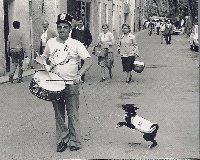 Leading
the Dance is a problem-solving tool developed by Canadian clicker trainer Sue Ailsby. It's
about your relationship with your dog, and is meant to be used in conjunction with your other
training. Sue has a long, successful history in every dog sport imaginable and is a very
skilled clicker trainer and clicker seminar presenter. This is her the latest incarnation. Leading
the Dance is a problem-solving tool developed by Canadian clicker trainer Sue Ailsby. It's
about your relationship with your dog, and is meant to be used in conjunction with your other
training. Sue has a long, successful history in every dog sport imaginable and is a very
skilled clicker trainer and clicker seminar presenter. This is her the latest incarnation.
Some of the items in the programme could be used for the
rest of the dog's life - we particularly suggest the feeding regimen, song, and the roadwork.
Other items will be done only until the dog understands his position in society. When he
graduates, release him from the items one at a time over a period of several weeks, watching
for him to go back to his old ways.
If there is any part of Leading The Dance that is liable
to get you bitten while you're doing it, DON'T DO IT and GET HELP from a competent trainer! If
any of the exercises are causing you and your dog more trouble than you can handle without
getting into a fight with the dog, leave them out. The more exercises you do, the faster your
results will be, but FIGHTING WITH THE DOG IS NOT THE POINT. Also, be SURE that Leading The
Dance is used as part of a coherent clicker training system. Remember that Leading The Dance is
about your relationship with the dog, not about beating him into submission!
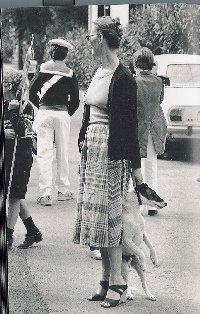 1.
Umbilical cord 1.
Umbilical cord
As much as possible when you are at home, keep the dog on leash and with you. Put a six
foot leash on the dog, and attach the other end of the leash to a sturdy belt around your
waist. Ignore the dog and go about your business. Having to constantly watch what you do and
where you go will not only bond the dog to you, but will help make you important in his eyes.
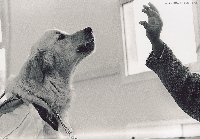 2.
Eye contact x 2 2.
Eye contact x 2
Twice a day, sit down with the dog between your
knees, and use a known cue such as Watch Me, or make funny noises, or tap the dog's nose and
then your own, or, if necessary, simply sit and wait for ANY eye contact, reward that eye
contact with a click or Yes! and quit.
3.
Obedience x 2
Twice a day, have a quick working session using
whatever the dog knows how to do (Down, Sit, Come, etc), repeat as needed. Train for a couple
of minutes each session. Do NOT touch the dog to praise him.
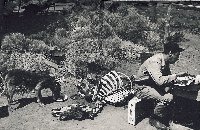 4.
Feed x 2 4.
Feed x 2
When food is left down for the dog to eat, the
dog owns the food. Instead, feed the dog twice a day in a confined area such as a crate or the
bathroom. Use a Feeding Ritual. Ask him if he's hungry, ask him to help find his dish, to help
find the food, ask him again if he's hungry, tell him to go to his area or get in his crate,
give him the food. As soon as he's finished, or as soon as he turns away from his food, or if
he doesn't begin eating immediately, take the dish away, throw away the food, and clean the
dish. If the dog is not successful at eating (doesn't eat his whole meal), give him half the
regular amount at his next meal, until he is cleaning the bottom of the dish. A successful meal
means he gets more at his next meal, until he is eating the amount that will keep him in
optimum condition. Use high-quality, low-bulk food. Water should be freely available all day.
Give no treats in the food. Dogs love rituals and you are teaching his body to get ready to eat
when he hears the beginning of the ritual.
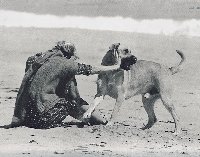 5.
Possession is 9/10 of the Law 5.
Possession is 9/10 of the Law
At least once a day, handle the dog. Repeat the
words These are my ears! This is my paw! This is my muzzle! This is my tail! as you handle him.
If he fusses, go slower. It's important that the dog has a positive experience - that he comes
to see that you will be handling him and it's of no concern to him. When he is completely
relaxed and accepts your handling, say OK and release him. If your dog will not allow you to
handle him like this without getting angry or getting away, DO NOT do this exercise. Do the
rest of the exercises and use the clicker to teach the dog to allow this handling later.
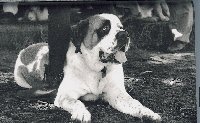 6.
Long Down-Stay 6.
Long Down-Stay
Do one 30-minute Down-Stay every day. You can
watch TV but the dog must be in plain sight and you must be aware of him. If he cannot stay
down on his own, confine him instead. Keep him in sight and, if he is fussing, reward him with
a click and a treat when he is NOT fussing.
7.
Sing a song
Make up a silly song using the dog's name. It
doesn't have to rhyme, but it should make you smile and get the dog's tail wagging. Sing it to
him (he won't criticize, I promise).
8. I'm THE Mommy...
Down
If your dog knows the cue 'down', at least once a day, just because you felt like it, tell the
dog to lie down. When he does, use your voice only to tell him he did a good job, say Okay, and
walk away. If your dog does NOT know the cue 'down', use the clicker to teach it to him.
9.
Leadership Is in the eye of the beholder
 Consider
life from the dog's point of view. He sleeps where he wants, he eats when he wants, he leads
you around. Any wonder he gets the impression that he's in charge? If he goes through a door or
into stairs or a hallway ahead of you, simply turn and walk back in the other direction. Try to
position him or yourself so you are leading and he is following. If he's lying down, don't walk
around him. Put your feet on the floor and shuffle right through him (note you don't kick the
dog, merely push him gently out of the way) - make him think about where you are and what
you're doing. When he orders you to let him out, take charge of going outside. Build a ritual
around the door. Focus his attention on you: 'Do you want to go out? Sit! ' When he sits, you
go to the door. 'Want to go out? Sit. Down. Sit. Stay.' Then open the door: 'Okay, go outside!'
You change the situation so you are the leader. Keep the dog on the floor. Not on the couch,
not on the chair, not halfway up the stairs surveying his domain, not in your lap, not on the
car seat. On the floor. Consider
life from the dog's point of view. He sleeps where he wants, he eats when he wants, he leads
you around. Any wonder he gets the impression that he's in charge? If he goes through a door or
into stairs or a hallway ahead of you, simply turn and walk back in the other direction. Try to
position him or yourself so you are leading and he is following. If he's lying down, don't walk
around him. Put your feet on the floor and shuffle right through him (note you don't kick the
dog, merely push him gently out of the way) - make him think about where you are and what
you're doing. When he orders you to let him out, take charge of going outside. Build a ritual
around the door. Focus his attention on you: 'Do you want to go out? Sit! ' When he sits, you
go to the door. 'Want to go out? Sit. Down. Sit. Stay.' Then open the door: 'Okay, go outside!'
You change the situation so you are the leader. Keep the dog on the floor. Not on the couch,
not on the chair, not halfway up the stairs surveying his domain, not in your lap, not on the
car seat. On the floor.
Don't leave the dog loose in the house or yard when
you're not home. Free run of the house when the Boss isn't home allows the dog to feel powerful
and responsible for the house and what happens in it. Don't allow the dog to sleep on your bed,
or on a child's bed. Dogs recognize the bed as a throne for the Boss. If he sleeps away from
you, however, he may think that you own the bedroom, but he owns the rest of the house. The dog
should sleep in your bedroom. If you can't have him sleeping in your bedroom (allergies, for
instance), confine him to his crate.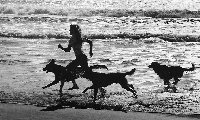
10.
Work off energy
Roadwork adult dogs four days a week. Start
small, but work up to a mile for small dogs, two miles for medium dogs, and three miles for
large dogs. Many problems will disappear with no more effort than road-working. You can jog
with the dog, or ride a bike, or lunge him with a Flexi, or use a motorised trike, or lend him
to a jogger who's afraid of being mugged. Be sure that puppies have ample opportunity to play.
The 'Come Game' (calling the puppy back and forth between two people and rewarding him for each
come) is excellent for giving puppies exercise AND for teaching them to come. Speak to your vet
about the difference between 'ample' exercise and 'too much' or 'not enough' exercise for
puppies.
11.
Busy hands are happy hands
Consider the things your dog likes - getting
petted? Food? Toys? Chasing a squirrel up a tree? Whatever it is, remember that YOU are the one
who can supply him with it. If he loves to chase a ball, he might jump at you, bark, try to
grab it out of your hand - if you throw it while he is behaving like this, he will continue to
behave like this because it got him what he wanted. If you wait until he is NOT jumping on you,
or until he is momentarily silent, or until he sits (even if it takes ten minutes), and THEN
throw the ball, you will be showing him that GOOD behaviour gets the ball.
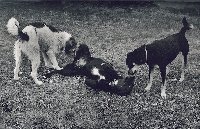 12.
Eliminate hormones 12.
Eliminate hormones
Have problem dogs neutered. Some problems will
solve themselves with no more effort than this. Not only will the dog be healthier and easier
to live with, but your life will be made simpler.
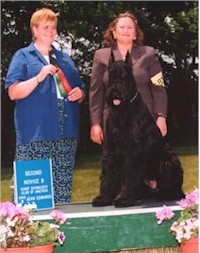 Susan
Finlay Ailsby is a retired obedience and
conformation judge. She has been 'in dogs' for over 40 years, having owned and trained
Chihuahuas, Miniature Pinschers, Australian Cattle Dogs, Miniature Schnauzers, Giant
Schnauzers, and a Portuguese Water Dog. Susan
Finlay Ailsby is a retired obedience and
conformation judge. She has been 'in dogs' for over 40 years, having owned and trained
Chihuahuas, Miniature Pinschers, Australian Cattle Dogs, Miniature Schnauzers, Giant
Schnauzers, and a Portuguese Water Dog.
She has put more than twice as many training titles on
Giants than anyone else in North America, and has trained for every legitimate dog sport
available including sled racing, schutzhund, hunting, tracking, freestyle, scent hurdle and
flyball, carting, packing, agility, water trials and herding. She is pictured right after a
judging assignment with winners Pat Malan and Titan.
Sue is an internationally known speaker on the subject of
humane animal training and has been fundamental in introducing clicker training to Canada and
the United States. She also breeds and trains llamas.
From Sally Bradbury,
Scallywags School for Dogs Southampton...
I use and teach the NILIF (nothing in life is free) principle. Excellent article. I
assume those that don't agree with this approach prefer to let their dogs go wrong and then
punish them for it.
From Pat Belliveau...
Last weekend I had the good fortune to be at a seminar by Sue Ailsby hosted by our
local group.....WOW!!!!! I'm glad her article will be available more widely. I
t helped me start off well with my dominant male PWD
puppy, now 10 months old and well behaved ...mostly.<g> Whenever he gets too full of himself,
he goes back on umbilical leash for a few hours a day which reminds him gently of his place in
the grand scheme. (26/01/01)
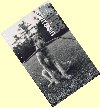 Black
& white photographs from: Dogs Dogs by Elliott Erwitt (Phaidon) Black
& white photographs from: Dogs Dogs by Elliott Erwitt (Phaidon)
Photo of Sue Ailsby: Pat Malan
| |
|